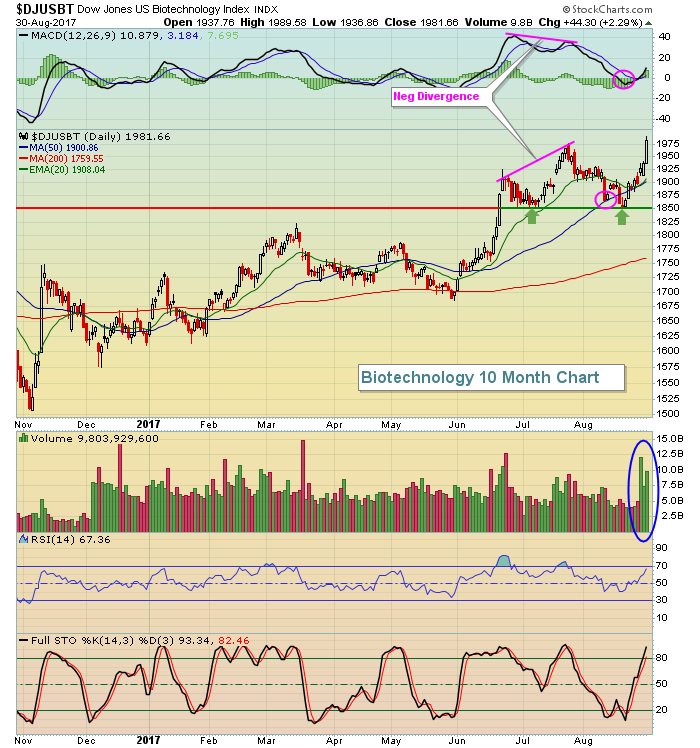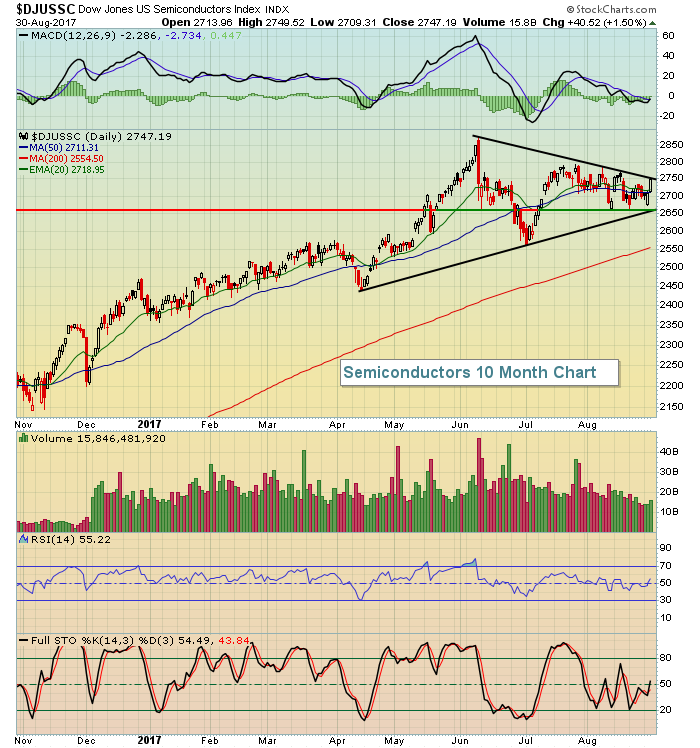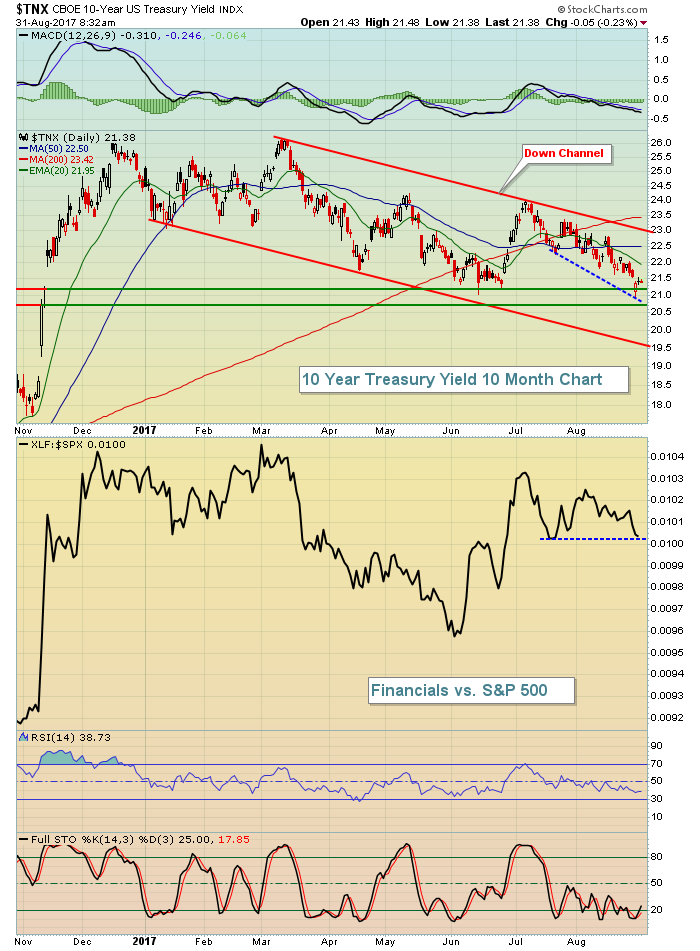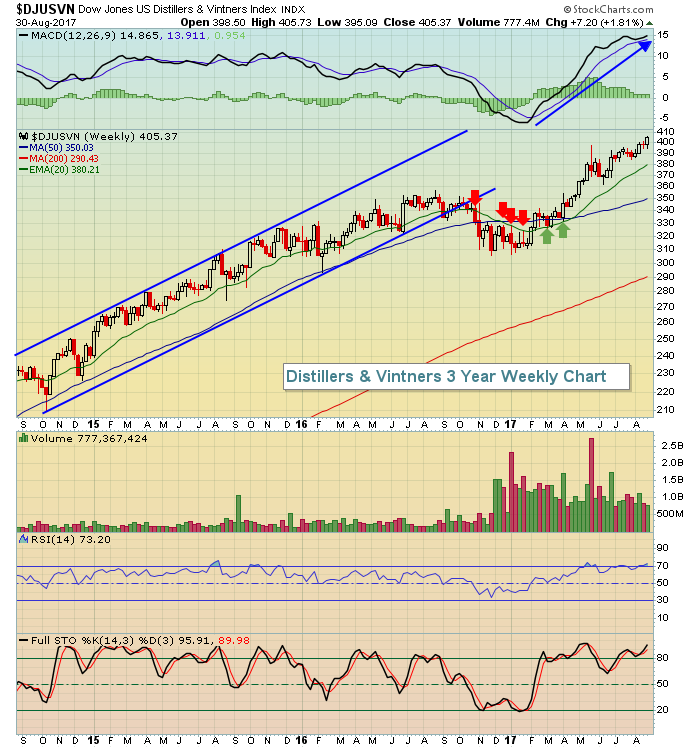Market Recap for Wednesday, August 30, 2017
The U.S. stock market benefited from a lot of the new and a little of the old on Wednesday as the Dow Jones U.S. Biotechnology Index ($DJUSBT) and the Dow Jones U.S. Semiconductors Index ($DJUSSC) posted solid gains to help lead the NASDAQ and NASDAQ 100 yesterday. The DJUSBT has risen approximately 7% in the past 8 trading sessions and the 2.29% gain yesterday cleared prior price resistance. This industry remains one of the very best technically as you can see:
 There was a short-term issue to resolve - slowing momentum in the form of a negative divergence. But the trip back to the 50 day SMA was accompanied by a MACD centerline reset (pink circles) and, since then, the DJUSBT has been on fire. Heavy volume to accompany the rise this week smells like accumulation to me. I'd expect continuing strength from biotechs into year end - with normal profit taking along the way.
There was a short-term issue to resolve - slowing momentum in the form of a negative divergence. But the trip back to the 50 day SMA was accompanied by a MACD centerline reset (pink circles) and, since then, the DJUSBT has been on fire. Heavy volume to accompany the rise this week smells like accumulation to me. I'd expect continuing strength from biotechs into year end - with normal profit taking along the way.
While the strength in semiconductors on Wednesday was great to see, this group is in a clear consolidation phase, highlighted by the symmetrical triangle below:
 The DJUSSC has held 2650 price support on multiple occasions and that price level is also intersected by the uptrend line within the triangle pattern. A break below 2650 would be short-term bearish for semis, while further strength from here would be bullish in breaking the downtrend line. Not pictured above is the longer-term negative divergence on the weekly chart. So while it's nice to see short-term strength here, the move is a bit suspicious given the slowing momentum that's apparent on its weekly chart.
The DJUSSC has held 2650 price support on multiple occasions and that price level is also intersected by the uptrend line within the triangle pattern. A break below 2650 would be short-term bearish for semis, while further strength from here would be bullish in breaking the downtrend line. Not pictured above is the longer-term negative divergence on the weekly chart. So while it's nice to see short-term strength here, the move is a bit suspicious given the slowing momentum that's apparent on its weekly chart.
Materials (XLB, +0.74%) actually had the distinction of being the best performing sector yesterday, despite the industry strength in biotechs and semiconductors. Mining shares struggled given the resurgence in the U.S. dollar ($USD).
Pre-Market Action
Mixed earnings reports and a slew of economic data have done little to slow progress in our major indices this morning. Wall Street appears poised to tack on additional gains as Dow Jones futures are up 63 points with a half hour left to the opening bell.
We're seeing bullish follow through in Europe this morning and that will no doubt aid U.S shares in their attempt to test the all-time highs established just a few weeks ago. The weekly MACD, however, is worsening so be very careful in the next attempt to clear 2500 fails.
Current Outlook
Since hitting its March 1st high, the S&P 500 has risen approximately 2%, not much over a six month period. Part of the problem has been the continuing rise in treasury prices and the corresponding falling yields. That has a direct negative effect on many financials, especially banks ($DJUSBK) and life insurance ($DJUSIL). Relative weakness in financials over the past six months has played a part in the slowing momentum of the benchmark S&P 500 and helps to explain the relative strength of the NASDAQ 100 (this index is mostly a non-financial index) over that same period. The NASDAQ 100 is up roughly 10% since March 1st. The direction of the 10 year treasury yield ($TNX) can significantly alter the relative performance of these two key indices. This is important because the TNX just hit a recent low and its low also happens to be in a gap support zone. Check this out:
 While the TNX has clearly been downtrending, the blue dotted lines above show an interesting relationship. Over the past 5-6 weeks, the TNX has fallen from 2.25% to 2.10%, but the XLF:$SPX ratio has held steady. The XLF has been testing its 20 week EMA recently (not pictured above), so the direction of the TNX from here is likely to be pivotal to the XLF performance. A break in the TNX below 2.10% would likely result in a quick selloff in financial shares, especially the aforementioned banks and life insurance companies. However, should this TNX yield support hold and yields begin trending higher, I'd expect to see outperformance in financial shares.
While the TNX has clearly been downtrending, the blue dotted lines above show an interesting relationship. Over the past 5-6 weeks, the TNX has fallen from 2.25% to 2.10%, but the XLF:$SPX ratio has held steady. The XLF has been testing its 20 week EMA recently (not pictured above), so the direction of the TNX from here is likely to be pivotal to the XLF performance. A break in the TNX below 2.10% would likely result in a quick selloff in financial shares, especially the aforementioned banks and life insurance companies. However, should this TNX yield support hold and yields begin trending higher, I'd expect to see outperformance in financial shares.
Sector/Industry Watch
Distillers & Vintners ($DJUSVN) are once again a very solid trading alternative during the S&P 500's consolidation phase. This group was completely out of favor in late 2016, but has recovered to help lead consumer staples (XLP) since then. Take a look at this chart:
 The red arrows highlight the trendline break and subsequent failures to clear overhead resistance at the declining 20 week EMA. However, once it regained that key moving average, it has continued to trade above it. The blue directional line shows that the weekly MACD has gained momentum with each new price high. The next rising 20 day EMA would be expected to hold and that's what I'd look for to set up trades within this space.
The red arrows highlight the trendline break and subsequent failures to clear overhead resistance at the declining 20 week EMA. However, once it regained that key moving average, it has continued to trade above it. The blue directional line shows that the weekly MACD has gained momentum with each new price high. The next rising 20 day EMA would be expected to hold and that's what I'd look for to set up trades within this space.
Historical Tendencies
Since 2010, the S&P 500 has had the tendency to struggle the two days prior to Labor Day. That contradicts the typical bullish behavior we see at the end of the month or early in the subsequent month. But over the past six years, we've witnessed anywhere from fractional gains to significant (3%+) losses and the technical picture remains very cloudy despite yesterday's strong gains. Consider some caution as we head into the end of the week and we get the latest government nonfarm payrolls report slated for Friday morning at 8:30am EST.
Key Earnings Reports
(actual vs. estimate):
CPB: .52 vs .55
DG: 1.10 vs 1.09
TD: 1.14 vs 1.03
(reports after close, estimate provided):
COO: 2.57
PANW: (.20)
Key Economic Reports
Initial jobless claims released at 8:30am EST: 236,000 (actual) vs. 237,000 (estimate)
July personal income released at 8:30am EST: +0.4% (actual) vs. +0.4% (estimate)
July personal spending released at 8:30am EST: +0.3% (actual) vs. +0.4% (estimate)
August Chicago PMI to be released at 9:45am EST: 58.6 (estimate)
July pending home sales to be released at 10:00am EST: +0.4% (estimate)
Happy trading!
Tom
